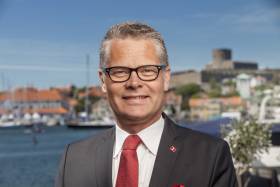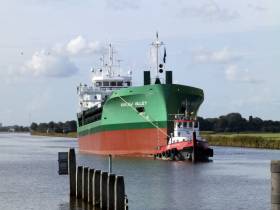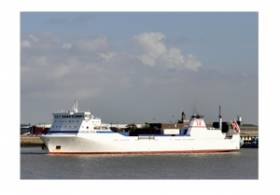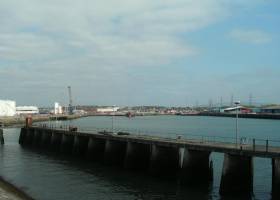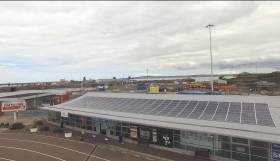Displaying items by tag: Ferry news
Seatruck ‘Highly Commended’ at Lloyds Global Awards
#AwardResults - Seatruck Ferries, the Irish Sea's only operator dedicated to unaccompanied ro-ro freight, was last night piped by the post in a category at the Lloyds List Global Awards, writes Jehan Ashmore.
The ‘Company of the Year’ award went to French container operator CMA CGM. However, Seatruck were 'Highly Commended' by the judges at the event regarded as the 'Oscars' of the worldwide shipping industry.
Seatruck part of the Danish owned Clipper Group, this year celebrated its 20th anniversary. The freight ro-ro operator has a network of three routes: Dublin-Liverpool, Dublin-Heysham and Warrenpoint-Heysham and as reported only this month launched a new Dublin-Bristol route.
The Port of Bristol is a major hub for UK car imports and the new route provides manufacturers an alternative option to enter the Irish marketplace.
Afloat.ie has identified Portbury as the location used as part of the Port of Bristol that also operates Avonmouth. The vessel deployed can also be revealed as the Clipper Ranger (165 unit capacity) which operates the new service with a weekend round trip. Otherwise the ‘R’ class ro-ro would be left idle in between serving routine Dublin-Heysham sailings.
Rare Launch in Irish Shipbuilding of Car Ferry at Arklow for Rathlin Island
#FerryLaunched – A newbuild and that of a car ferry, which is rare in Irish shipbuilding, was launched at Arklow, Co. Wicklow yesterday, writes Jehan Ashmore.
The 6 vehicle / 140 passenger ferry, Spirit of Rathlin was launched from Arklow Marine Services, which involved the Belfast registered newbuild hoisted off the quayside by a floating crane, Lara 1 and lowered into the River Avoca. The self-propelled crane barge was chartered to the the port for the operation and is more commonly known as the former Mersey Docks & Harbour Board's Mersey Mammoth.
Spectators lined the banks opposite North Quay, to witness the proud moment for the boatyard which was awarded the contract by Northern Ireland’s Department for Infrastructure (DFI). The DFI is still in the process of evaluating the bids for tenderers as previously reported to operate the new Rathlin ferry between the island off Co. Antrim and Ballycastle.
Arklow Marine which is owned by the Tyrrell family, now in their fifth generation of running the marine engineering business synominous with Irish shipbuilding that can trace its origins to 1864. Among the most famous of vessels launched was the State's first custom built sail-training ship, the brigantine, Asgard II built in 1981.
Asides car ferry building, the yard have also designed and constructed vessels including aluminium catamarans, amphibious vessels, trawlers, tugs, and workboats. They also carry out conversion, repair and refit work.
In more recent years AMS has branched out into specialist newbuilds for the offshore energy sector, with the completion of Wind Farm Service support vessels for the UK market.
New CEO Mårtensson Appointed at Stena Line
#NewStenaCEO - A new CEO has been appointed by Stena Line, the Swedish owned company which is one of Europe’s largest ferry operators with 35 ferries and 22 routes in northern Europe.
Deputy CEO Niclas Mårtensson assumed the position with his appointed today as CEO by Stena Line. The current CEO, Carl-Johan Hagman, will resume his position as Chairman of the Stena Line board and will also remain in the role as Head of Shipping at Stena AB.
Niclas Mårtensson has more than 10 years’ experience of working in different senior positions within Stena Line including Route Manager in Germany and Poland, COO and most recently as Deputy CEO.
“This appointment is a natural step in our development process. We are pleased that we have recruited a CEO internally who will be able to fully focus on realising the strategy,” said Carl-Johan Hagman.
“I’m really looking forward to the exciting challenge of, with our customers in mind, realising our journey towards a sustainable and digital company. The transportation needs of our freight and travel customers continue to increase and evolve and Stena Line, with its comprehensive European network, is well positioned to meet that demand in a sustainable way”, said Niclas Mårtensson.
Ferry Due from Wicklow Yard While Arklow Dutch Built Cargoship Makes Sea Trials
#SeaTrials - As a new car ferry is to be launched in Co. Wicklow yard as previously reported, an Arklow Shipping Dutch flagged and built cargoship is making first sea trials today, writes Jehan Ashmore.
The Royal Bodewes newbuild no 724, Arklow Valley, a cargoship with a modified bow design compared to her more distinctive sisters to improve energy efficiency, had been transported yesterday under tow. This involved a pair of tugs to take the near 87m long newbuild from the inland shipyard near Groningen to Delfzijl.
Further along the coast at Eemshaven, is where Arklow Valley had sailed to and this afternoon the newbuild was in the open sea off the Western Frisian Islands in the North Sea.
She is the fourth so far completed from 10 in a series of 5,100dwat Bodewes Traders on order to ASL. They will be part of Arklow Shipping Nederlands B.V. with an office located in Rotterdam.
The new series or ‘V’ class are all Dutch flagged and began with leadship, Arklow Vale. The single hold vessel was launched and named just over a year ago, by ships godmother, Mrs Mari Louise de Jong.
Arklow Marine to Launch New Car Ferry for Rathlin Island Route
#NewBuild - Arklow Marine Services are to launch a new car ferry which is to serve Rathlin Island off the Antrim coast, writes Jehan Ashmore.
Northern Ireland’s Department for Infrastructure (DFI) awarded the contract for the 6 vehicle /140 passenger ferry to the Co. Wicklow based boatbuilder, headed by Billy and John Tyrell.
Responding to Afloat.ie a DFI spokesperson said the Department is still in the process of evaluating the bids for tenderers to operate the new Rathlin ferry.
Following delivery of the new ferry to be named Spirit of Rathlin, the newbuild is to undertake trials for three to four weeks. In addition crew familiarisation is to take place, after which the vessel is expected to come into operation.
The Ballycastle-Rathlin route is operated by the Rathlin Island Ferry Ltd which currently uses three vessels, Canna, Rathlin Express and St. Sorney.
Canna is an ageing ‘Island’ class car ferry, which dates to 1976, having originally served the Scottish West Isles for CalMac. The 40 year-old ferry bow-loading vessel has the same vehicle and passenger capacity of the newbuild.
In 1997, Canna was transferred to Rathlin with CalMac contracted to run the service. In the following year she was chartered by the Scottish publically funded ferry company to Rathlin Island Ferry Ltd who took over the operation of the service.
In 2009 the passenger-only, Rathlin Express, an aluminium catamaran craft, also built by Arklow Marine Services entered the route.
This leaves the third vessel, St. Sorney, also passenger-only and which serves as a reserve boat. The 40ft ‘Lochin’ cruiser was built by Ryan & Roberts of Limerick.
Added Freight Capacity on Stena Route to Europe via UK Landbridge
#FreightCapacity - Irish freight heading to and from mainland Europe via the UK landbridge will have additional freight capacity as Stena Line respond to demand on a North Sea route to the Netherlands.
The operator on the Killingholme-Rotterdam (Europoort and Hoek van Holland) route are to introduce a second ship from the Killingholme to Europoort. RoRo vessel Caroline Russ is to be enter service to operate three times weekly from Killingholme on the UK east coast to Europoort, with the first departure from the Dutch port on October 31.
The ship will join current RoRo ship, Stena Scotia (a former Irish Sea freightferry) on the route. The frequency will hereby increase to six departures per week in each direction. The Stena Scotia was introduced on the route September 2014 as a complement to the two freight ships, the Stena Transit and Stena Transporter on the Killingholme-Hoek van Holland route.
Annika Hult, Route Manager at Stena Line North Sea says: “We have seen a strong growth in the transport market to the UK over the past several years. We introduced our freight ship the Stena Scotia in 2014 in order to accommodate growing volumes of traffic. I am very pleased to announce that we will now take the next step in the strategic development of our Killingholme-Rotterdam (Europoort) route.”
“We expect trade to remain strong and want to be in the best place to service our customers and meet additional demands. Europoort continues to develop as an important freight hub for Stena Line and we are confident our customers will react positively to our expanded service”.
Facts: Caroline Russ
Type of ship: RoRo
Trailers: 102
Passengers: 12
Year of construction: 1999
Length: 153 m
Width: 20.6 m
Max speed: 20 kn
Isle of Man Ferry Reschedules Service Due to Dredging Problems in Heysham
#Dredging - The Isle of Man Steam Packet is running into problems at Heysham, its main port in England.
The ferry company according to IOMToday is blaming a ‘failure of an agreed dredging programme’ for disruption to Douglas-Heysham services from today, Friday to next Monday.
A revised schedule for ropax Ben-my-Chree services has been announced.
This is due to a combination of tidal conditions and a lack of agreed dredging at Heysham means there will be insufficient under keel clearance for the vessel to operate its planned sailings.
For information on the following re-scheduled sailngs click here
Departing Barge Marks Final Chapter of Stena’s Association With Dun Laoghaire
#FinalLink – The final chapter of Stena Line’s history with Dun Laoghaire Harbour was marked this morning when a barge used to dismantle the former HSS berth departed under tow, writes Jehan Ashmore.
MTS Indus towed the barge SB-5018 that was used in the harbour as a floating platform. The red-hulled barge was moored next to the ferry terminal linkspan at Berth No. 5 on St. Micheals Pier.
The specialist custom built linkspan for berthing operations of HSS Stena Explorer lasted for almost two decades of the Dun Laoghaire-Holyhead route that closed two years ago this month. The loss-making route led Stena to consolidate existing operations out of neighbouring Dublin Port on a route also to the north Wales port.
Dun Laoghaire Harbour Company are looking for a new operator to restore the seasonal service next year, but using the adjacent Berth No. 4 alongside St. Micheals Pier. This linkspan was last used in 2011 by a smaller fast-ferry, Stena Lynx III.
Originally the plan was to tow the Stena HSS linkspan away from the port, by placing on board the barge, however the breakers torch was used instead on site at the ferry terminal.
This is where the Swedish registered barge also acted as a support to the specialist linkspan (see yesterday’s report photo) from where the tug departed and is under way ironically bound for Holyhead. The port in Anglesey is operated by the Swedish owned ferry operator whose headquarters are based in Gothenburg.
Dismantling work by the contractors in Dun Laoghaire had begun earlier this summer to remove all Stena owned berth infrastructure at the site of the purpose built ferry terminal. This paved the way for the introduction of the revolutionary HSS Stena Explorer fast-ferry catamaran craft in 1996.
Asides the linkspan, gone are now the passenger gangways and associated equipment at No 5 berth. The concrete supporting columns of the gangway however remain as well as the jetty and associated dolphin structure.
Not all the dismantling work was carried out on the barge. Other parts were broken up onshore from where vehicles from the HSS Stena Explorer used to disembark or arrive at the marshalling area. It was from here that awaiting trucks were loaded to be disposed by scrap merchants.
Tug Arrives At Dun Laoghaire Harbour Following Dismantling of Stena HSS Related Infrastructure
#LinkspanScrap -A tug arrived in Dun Laoghaire Harbour this morning to remove a barge involved in the process to dismantle infrastructure of the former Stena HSS berth, writes Jehan Ashmore.
MTS Indus had sailed from Brixham in the UK to moor alongside the barge that arrived earlier this summer at St. Michaels Pier, from where Stena Line for almost two decades had operated as the only major client of Dun Laoghaire Harbour Company.
Stena’s pioneering HSS fast-ferry service to Holyhead launched in 1996 was revolutionary, bringing a completely new concept of ferry travel on the Irish Sea and setting new technical innovation globally. The HSS Stena Explorer was the first of a trio of HSS1500 (number reflecting passenger capacity) class craft capable of also carrying large freight trucks.
In more recent years, Stena suffered heavy losses and the near 20,000 gross tonnage craft was withdrawn in 2014, though an existing route from Dublin Port to the Welsh port was consolidated with the introduction of larger second replacement ferry.
Contractors at the Dun Laoghaire ferry terminal began work earlier this summer to dismantle all Stena related infrastructure consisting of the adjoining passenger gangway, linkspan and associated equipment at No 5 berth. These constituent parts were broken up on site, using the barge as working platform as well to torching work carried on shore on the site of the vehicle marshalling area, from where scrap merchants loaded trucks for removal.
Yesterday it was observed the lashing of equipment on the barge in addition to containers, portacabins and heavy machinery used in the works. According to DLHC, the MTS Indus was expected to tow the red-hulled barge to the Holyhead today. The north Wales port which is operated by Stena, however may not have the tug arriving until tomorrow, again weather permitting.
The works carried along the centre of the Dun Laoghaire Harbour waterfront also saw the removal of the pontoon located next to Berth No. 4. This is now the only berth complete with linkspan on St. Michaels Wharf.
With the completion of the work to remove Stena infrastructure, Berth 4 will now be made available for a new operator, should DLHC be successful in securing a suitable client in a tender process to resume a seasonal-only service next year.
Solar Support Deployed at Stena's Port of Holyhead
#SolarPort - As part of a drive to become the world’s greenest ferry operator, Stena Line has just delivered an innovative solar project at its Port of Holyhead in Wales.
The project involved the fitting of four 50kWp Solar PV panel arrays to the roofs of terminal buildings, garage and shore shop. Stena Line teamed up with Eco Environments Ltd, a grid-connected and off-grid power specialist. The project was completed on time and on budget over a 4-week period during the summer with no interruptions to the port nor business to daily ferry operations.
The energy efficiency stats and associated carbon reduction levels around the project are impressive. It estimated that the panels will saved approximately 89 432 kg CO2 annually, provide 164 400 kWh of electricity for use onsite and will provide a yearly benefit worth £27,276 in electricity savings together with additional government feed-in tariff revenue. The pay back for the system is estimated to be less than seven years.
Wyn Parry, Stena Line Port Manager, Holyhead, said: “This is a very innovative and exciting project for us to be associated with. Initiatives like this one point the way forward and, as a company, we need to focus on it if we are to achieve our vision of becoming the greenest ferry operator in the world. While the savings themselves are relatively modest from a financial perspective, if we look at this as a small project within a much more comprehensive approach to future sustainability then I think it’s an important step forward and one that I’m sure can be easily replicated across other parts of the Stena Line and wider Stena Group businesses.”





























